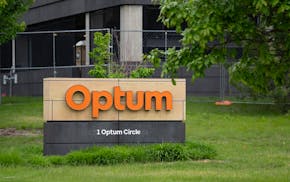At a bar in western Minnesota's Benson on Tuesday night, citizens pressed a natural gas company about a pipeline that aims to ferry dairy cow-emitted biogas for use as green energy.
While many asked questions about right-of-ways and a potential natural gas hookup to local communities down the road, some groups aired worries about how a project to convert livestock waste might supercharge a divide between small or medium-size farms and the state's largest dairies.
"Is this going to improve the stench that we get on this dairy?" asked Elaine Mittenness, a neighboring farmer. "Right now, it's impossible to have your windows open."
Illinois-based Amp Americas is building processing facilities for what the industry calls renewable natural gas at four western Minnesota farms: Meadow Star Dairy, East Dublin Dairy, Swenoda Dairy and Louriston Dairy. Morris, Minn.-based Riverview, the largest dairy in the state, owns all of them.
Amp Americas captures methane from livestock waste and converts it for use as natural gas. From there, Dooley's, a small company based in Willmar, plans to transport the gas to the massive Alliance Pipeline system that runs from British Columbia to Chicago. Dooley's would build about 28 miles of pipe through three counties: Chippewa, Kandiyohi and Swift. The pipeline itself would cost about $13.9 million, mostly in construction and labor costs.
Dooley's filed an application with the Public Utilities Commission (PUC) for a route permit in September, though only a small portion of the pipeline needs PUC approval. Dooley's will need local approval, too, said owner Randy Dooley.
If all goes to plan, Dooley's would start pipeline construction later this year and open the pipeline in August.
Pipe dream
Amp Americas didn't provide details of the project. But Andy Dvoracek, the company's vice president of business development, did give an overview to the Kandiyohi County Board of Commissioners in October.
Dvoracek said the project was fully funded and under construction. And he said it's similar to an existing project in Stevens County where the company is producing gas from three Riverview farms. At each farm on the new project, Dvoracek said Amp would build anaerobic digesters that take up two or three acres and look like big silos. Then there are gas plants that take up about an acre.
"These are small scale in the grand scheme of gas processing," Dvoracek said.
The gas can generate credits in markets for decreasing carbon emissions because it takes carbon pollution from cows to displace the use of traditional natural gas. Dvoracek said the biggest market is in California, where the company sells gas for transportation. The company has 14 projects in the U.S., Dvoracek said in October.
"This project will ultimately have beneficial effects through the production of [renewable natural gas] from four dairy farms rather than the manure gas being immediately released into the atmosphere," wrote Dooley's in a filing with the PUC.
In Minnesota, the gas from livestock is also valuable to natural gas utilities hoping to slash carbon emissions, which is an inherently difficult task when the main product is a fossil fuel. Xcel Energy has proposed spending $3.5 million to buy a small percentage of "environmental attributes" Amp Americas generated in a five-year agreement, said spokesman Theo Keith.
The pilot is part of a broader Xcel plan filed in January under a state law that helps gas companies test innovative ways to reduce climate impact. Those attributes are credits similar to carbon offsets and represent environmental benefits of the gas, Keith said.
In filings with the PUC, Xcel said it expects the project as a whole to prevent 150,000 metric tons of carbon emissions a year, equivalent to the output from more than 30,000 cars per year.
Airing grievances
But to convert a waste stream from the largest dairies into a profit stream has alarmed some farming and environmental groups in rural Minnesota, who charge the project will only exacerbate concentration in the farming industry.
"It's about more than a pipeline," Anne Borgendale, communications director for CURE, an environmental group based in Montevideo, Minn., said Tuesday.
In public filings before Tuesday's hearing, CURE, as well as sustainable farming organization Land Stewardship Project, sounded notes of alarm that Dooley's pipe — and the accompanying digester infrastructure — would supersize dairies, creating tougher competition for independent farmers and further pollution of waterways with the application of cow manure as fertilizer to fields, which can cause runoff.
"The incentive," wrote Sarah Mooradian, CURE's government relations and policy director, in a filing with the PUC, "[is] to continue to produce manure and perhaps increase manure production merely to rack up additional income for the methane that would not have been produced but for this project."
Minnesota currently counts 16 manure digesters, according to the Minnesota Pollution Control Agency.
Stevens County Administrator Rebecca Young said the Amp facility there has been operating for several years and earned approval without opposition. But earlier this month, the company REV LNG withdrew a separate application in Stevens County to build a similar renewable natural gas project using waste from dairy farms. But that proposal faced local opposition in part because it involved trucking gas, not piping it, Young said.
The permitting also comes at a time of ever-hastening decline in Minnesota's dairy farm landscape. The state lost nearly 150 dairy farm permits between January 2023 and year's end. On Thursday, U.S. Department of Agriculture Secretary Tom Vilsack will visit St. Charles, Minn., to tout investments in federal clean energy grants, many of which have gone to farmers in Minnesota to procure manure digesters.
University of Minnesota Prof. Roger Ruan said manure digesters have long been used in the sustainability-conscious European Union. Rather than applying cow manure onto fields, dairy farmers can use digesters to convert methane gas coming off lagoons and tanks for other uses, such as the production of energy.
"So far, we haven't really paid a lot of attention to this wastewater application," said Ruan, director of the U's Center for Biorefining. "We only think of [manure] as a fertilizer to grow plants. But so much of the nutrients is lost, and it's actually polluting our streams and waterways."
But that technology has struggled to gain relevance in the U.S. While more than 600 digesters operate in Europe, according to Penn State Extension, only 14% of the world's systems reside in the U.S.
In Stearns County, the heart of Minnesota's dairy belt, a separate venture that aimed to build large digesters, producing biogas from methane, folded after the Danish company's parent, petroleum conglomerate Shell, suspended development in the U.S.
Methane emitted from cows' flatulence and burps contributes to global warming, which is why the greenhouse gas drew focus at the most recent COP summit in Dubai. Proponents tout digesters as a win for the environment, including Minnesota's polluted waterways and air.
On Tuesday night, after a local resident who lives close to the pipeline route asked about possible decline in land value, Dooley responded, "If there's any impact to your property, it's going to be positive."

Delta hiked fares for solo travelers, until Twin Cities travel experts caught the change

In first speech back, UnitedHealth's new CEO pledges to review hot-button issues

A child had measles at Mall of America, concerning state health officials who don't know source

Ramstad: Gov. Walz, things are not getting done in Minnesota
